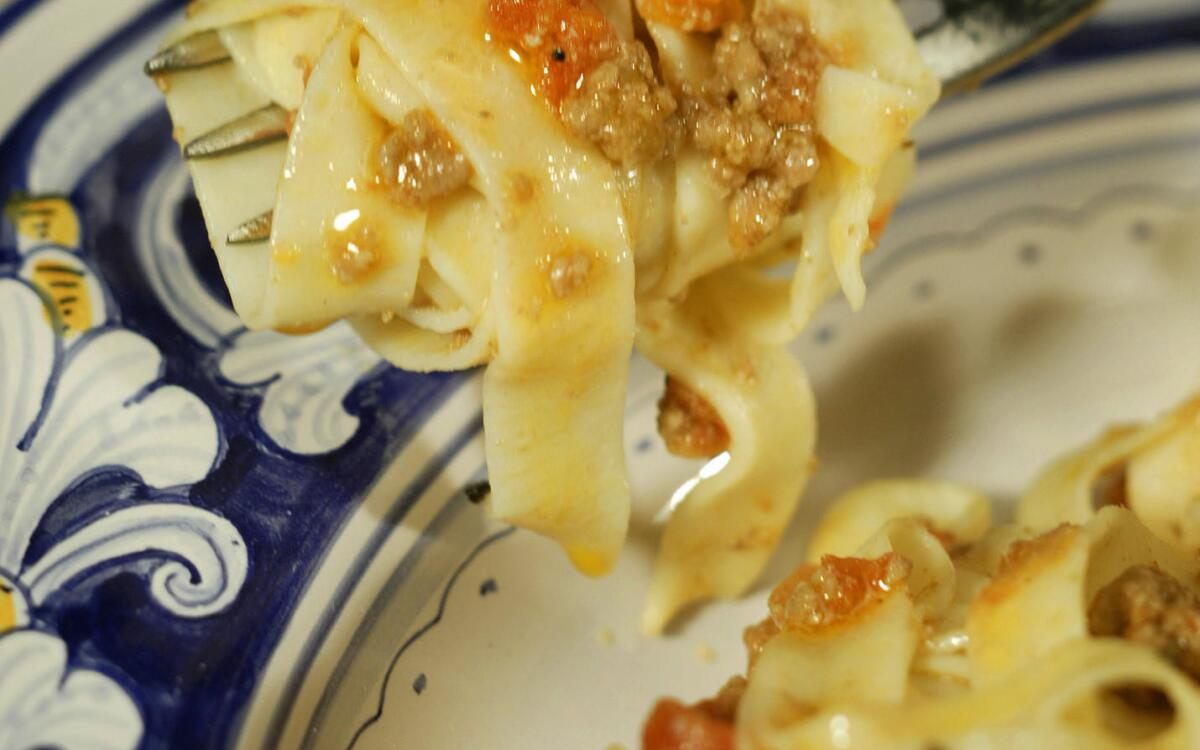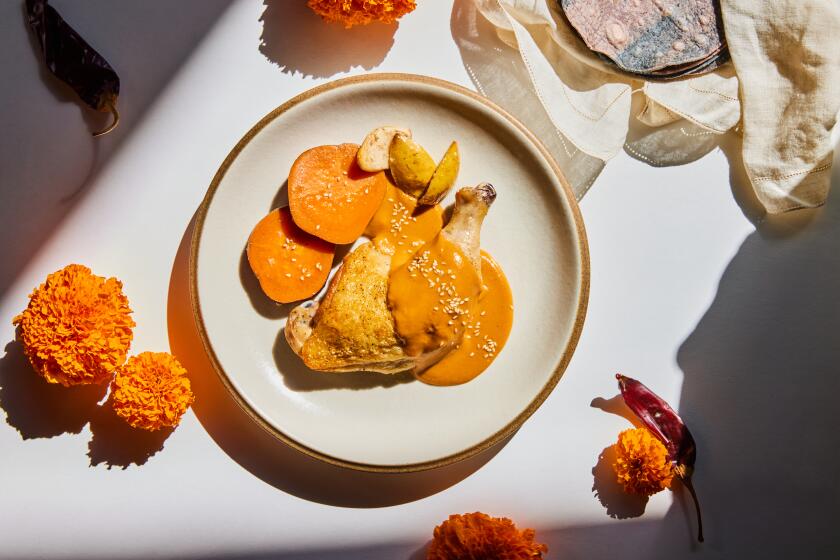Ragu alla Bolognese

About 15 years ago, traveling along the Italian Riviera, I’d had all I could take of the brave new Italian foods I had just discovered: walnut cream sauce and sun-dried tomatoes and gnocchi and fresh mozzarella. (Well, they were new to me, anyway.) I wanted something hearty. So as I sat one evening in a cafe in Genoa, I chucked any notions I had of being a culinary sophisticate and asked the waiter if, per favore, I might have a bowl of pasta alla Bolognese.
That was it. “You-a in Genoa!” the man screamed, arms flailing in the air. “In Genoa, you getta pasta Genovese. You want pasta Bolognese, you go to Bologna!”
What I wanted, of course, was meat sauce. But what I didn’t know is that the word for meat sauce in Italy is ragu. Bolognese, the proper name of which is ragu alla Bolognese, means ragu of Bologna. Regional pride being what it is in Italy, the request I’d made was a bit like going to a friend’s house for dinner and asking the mother to please make her meatloaf like my mother’s.
The word ragu comes from the French word for stew -- ragout -- which in turn comes from the verb ragouter, meaning to stimulate the appetite. And indeed it does. Ragu is not a specific sauce, but rather any meat sauce cooked long and slowly, until the meat is meltingly tender and the sauce -- infused with the meat’s juices -- is luscious and rich. You use it to sauce pasta, gnocchi, polenta -- or even risotto.
And every region has its version. In Trieste, ground beef ragu is redolent of fresh thyme and marjoram. In Abruzzi, ragu is often made with lamb, and on the island of Sardinia, wild boar is the standard meat used for a tomato-based ragu. Did you think ragu was just a brand of sauce in a jar? There is one that sort of looks like that: ragu alla Napoletana. In this version, large chunks of meat -- beef, pork, veal or a combination -- are cooked in tomato sauce and, traditionally, removed from the sauce and served as a second course.
Even if I had gone to Bologna for my meat sauce, as the waiter suggested, I wouldn’t have recognized the Bolognese I would have been served there. While “Bolognese” is undoubtedly the most popular ragu in this country, it is also the most misunderstood. The ragu you get by that name is usually a characterless tomato sauce with pea-like bits of ground beef floating in it, bearing little resemblance to anything you’d find in Bologna. And not, in any sense, a ragu.
True ragu alla Bolognese contains no tomato sauce -- just enough fresh or canned tomato to add a hint of sweetness and another layer of flavor to a subtle, complex mix. Like all ragus, Bolognese is characterized by its long, slow cooking, which in this case starts with simmering the meat in milk (to mellow the acidity of the raw tomatoes added later) and wine (some use white, others red), after which the tomatoes are added. The whole lot is cooked together for about two hours, at what Marcella Hazan calls “the laziest of simmers” in her book “Essentials of Classic Italian Cooking.”
How L.A. does it
There are a number of delicious ragus at restaurants here that call themselves “Bolognese.” At Valentino, chef Steven Samson makes one with hand-chopped beef. At Campanile, chef Mark Peel makes his with richly marbled prime rib cap braised like short ribs, then shredded and tossed with crispy fried trenne pasta. While these ragus are certainly complex and deeply flavored and altogether compelling, according to Hazan -- America’s ambassador of Italian cuisine and herself a Bolognese -- when it comes to ragu alla Bolognese, “The meat used is ground beef. Period.”
For ragu in the broader sense, it’s any meat goes. Depending on the region or the season, it can be made with beef, pork, wild boar, veal, venison, duck, squab, even seafood. Or as Gino Angelini, chef at Angelini Osteria and La Terza, says: “Whatever you have on the farm.” Angelini comes from Rimini, a city in Emilia-Romagna, the region of which Bologna happens to be the capital.
Angelini serves some kind of ragu at his eponymous restaurant every day, so when I wanted to make a duck ragu, I enlisted his help. The chef instructed me to start with a soffritto, in this case a mixture of chopped celery, carrot and onion, sauteed in olive oil.
Soffritto, which can also include other ingredients, such as garlic, herbs or pancetta, is the base upon which any ragu is built.
In a separate frying pan over blazing heat, he had me fry my quartered whole duck, rendering off the fat and leaving me with a nice, crisp skin. I combined the duck and soffritto, added wine, tomatoes and vegetable broth to the pan, put a lid on it and let the duck simmer, virtually undisturbed, for the next two hours. I then pulled the duck meat from the bones, chopped it and returned it -- along with its chopped liver for added richness -- to the pot, where it cooked still more to marry the sauce and the meat.
The long cooking necessary for making a great ragu shouldn’t be off-putting; it’s part of its appeal. There’s something so satisfying, especially as the days grow colder and the nights fall earlier, about a house filled with delicious, savory cooking smells, not to mention the anticipation of a meal with the kind of richness that only slow simmering provides. You’ll find yourself checking on the pot more than you actually need to, because it’s so wonderful to see and smell and taste the progress as the soffritto and stock begin to meld and turn into a rich, creamy gravy.
The genesis of this kind of cooking is obvious in the context of Italian history and culture. “It’s an economy deal,” says Joyce Goldstein, author of “Italian Slow and Savory.” “It’s making meat do two things.” In Italy before World War II, meat was a delicacy, too costly for most families to enjoy on anything but special occasions. Even today, ragu such as Bolognese is not for everyday pasta, but something to be savored on a Sunday afternoon with friends.
Cooking ragu allowed earlier generations to stretch their meat, as it would be used first to infuse the sauce with its fat and flavors, and then, for many ragus, removed from the sauce and served separately either as the second course or at a different meal altogether. Also, the cuts of meat that work best are the least expensive, such as shoulder and butt, whose marbling makes them ideal for long, slow cooking. What’s more, by using the sauce to dress pasta, it naturally went even further.
Today, the meat for a ragu like Napoletana is, especially in this country, often chopped or shredded and added back to the sauce, a practice that invites speculation as to the origin of the sauce Americans call Bolognese.
Many of the first Italian immigrants to this country were from Naples. For these immigrants, according to Goldstein, eating or serving meat with pasta was a sign of their newfound prosperity. Meatballs went from a size just bigger than a golf ball, and something eaten by themselves as a second course, to tennis ball-size monstrosities served -- an anomaly to any Italian -- atop a mountain of spaghetti.
As these Neapolitan immigrants became more prosperous (and found meat in the United States decidedly less expensive than in the old country), perhaps they began to add it back to their traditional tomato sauce and then gave it the name for Italy’s most famous such sauce: Bolognese.
On top of spaghetti?
In Italy, Bolognese is traditionally tossed with handmade tagliatelle (which comes from the word tagliare, meaning “to cut,” referring to the fact that the ribbons are hand-cut, with scissors, from the sheets of rolled-out dough). Or it may be layered with bechamel and spinach lasagna, a perfectly executed version of which is served at Angelini, topped with leaves of fried basil.
Hazan finds it curious that Bolognese has become popular in the United States, England and other countries outside Italy -- always served over spaghetti. In Bologna, she points out, this would never happen. “Bolognese’s message becomes muted,” says Hazan, “when it is served over spaghetti.”
Any ragu needs to be tossed with pasta shapes that stand up to the heft and richness of the sauce: rigatoni, conchiglie or fusilli. Pappardelle is also a popular choice, especially for ragus made with game. The richness of the egg pasta is able to bear the weight of the dish.
Besides being tossed with pasta or gnocchi, ragu is often served atop creamy polenta or stirred into a risotto. This last suggestion may sound strange, but in fact, it’s a great way to use up a small amount of leftover ragu. Since all the work of layering ingredients and cooking up a soffritto has been done, you skip that stage of risotto making. Instead, you simply stir the ragu into the rice after it has been toasted, then add broth in stages, as in any risotto, until you have a rich, hearty, goulashy kind of dish that is delicious when you have a craving that nothing but meat sauce will satisfy.
Which is what I experienced that memorable evening on the Italian Riviera. What I really wanted was meat sauce, however it happened to be made. Had I said “ragu” instead of “Bolognese,” rather than the pasta with pesto and potatoes that the waiter set down without any further input from me, I might have been served a bowlful alla Genovese: long ribbon-like pasta dressed with a sauce of tender chunks of beef and porcini mushrooms. Shoulda, coulda, woulda.
Heat the oil, 3 tablespoons butter and the onion in a large high-sided skillet over medium heat and cook, stirring often, until the onion is translucent, about 5 minutes. Add the celery and carrots and cook for about 2 minutes more, stirring to coat the vegetables with the butter.
Add the ground beef, a pinch of salt and a few grindings of pepper and cook, crumbling the meat with a fork, until it has lost its raw, red color. Add the milk and simmer it gently, stirring frequently, until it has bubbled away completely, about 15 minutes.
Add the nutmeg and stir. Add the wine and let it simmer until it has evaporated, about 25 minutes. Add the tomatoes and stir thoroughly to coat all the ingredients well. When the tomatoes begin to bubble, turn the heat down to cook the sauce at the laziest of simmers, uncovered, for 3 hours or more, stirring from time to time. You will need to add water to the pan occasionally to prevent the meat from sticking.
Taste for salt and toss with cooked, drained pasta and the remaining tablespoon of butter. Serve with freshly grated Parmesan on the table.
Get our Cooking newsletter.
Your roundup of inspiring recipes and kitchen tricks.
You may occasionally receive promotional content from the Los Angeles Times.















